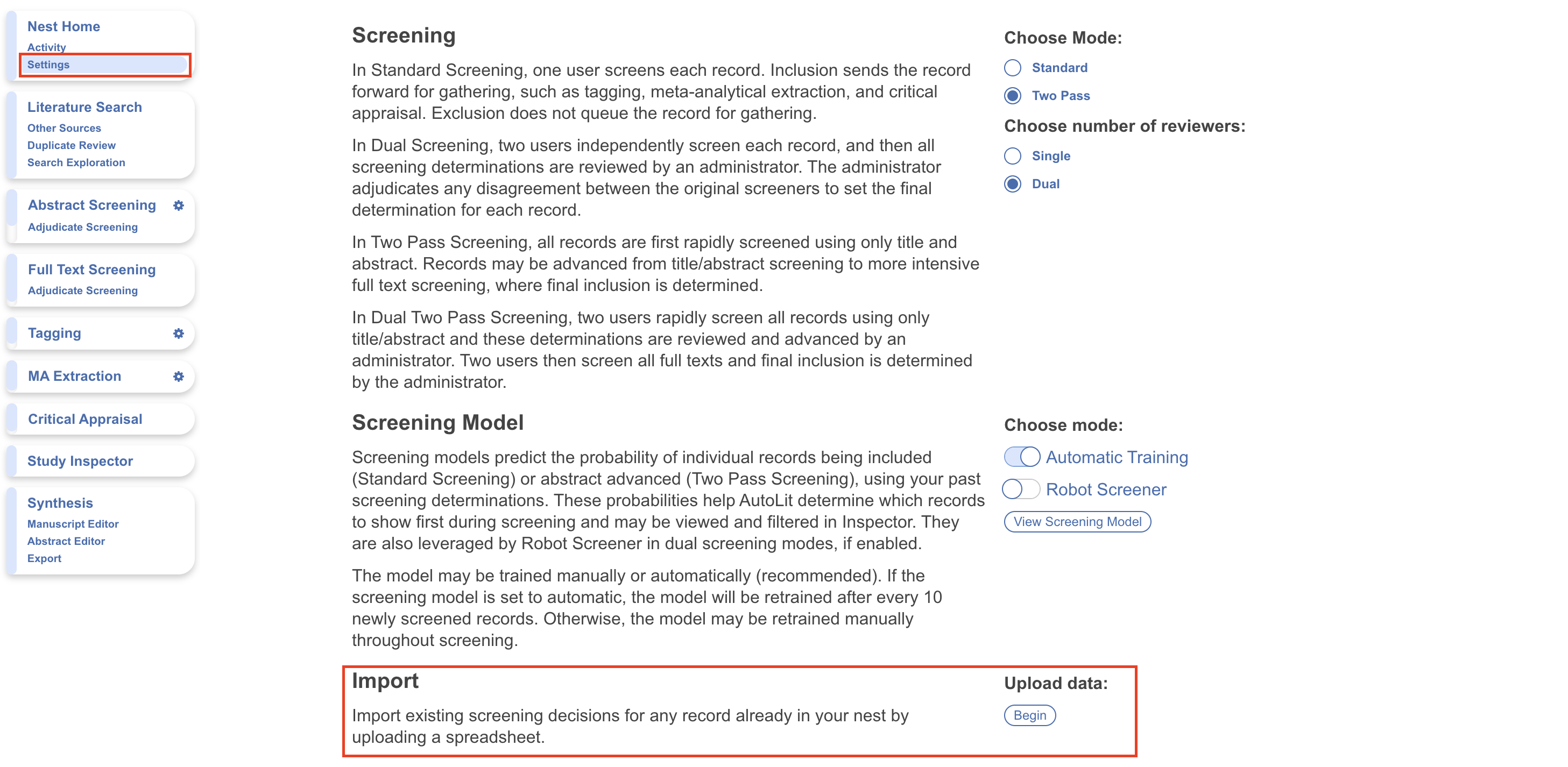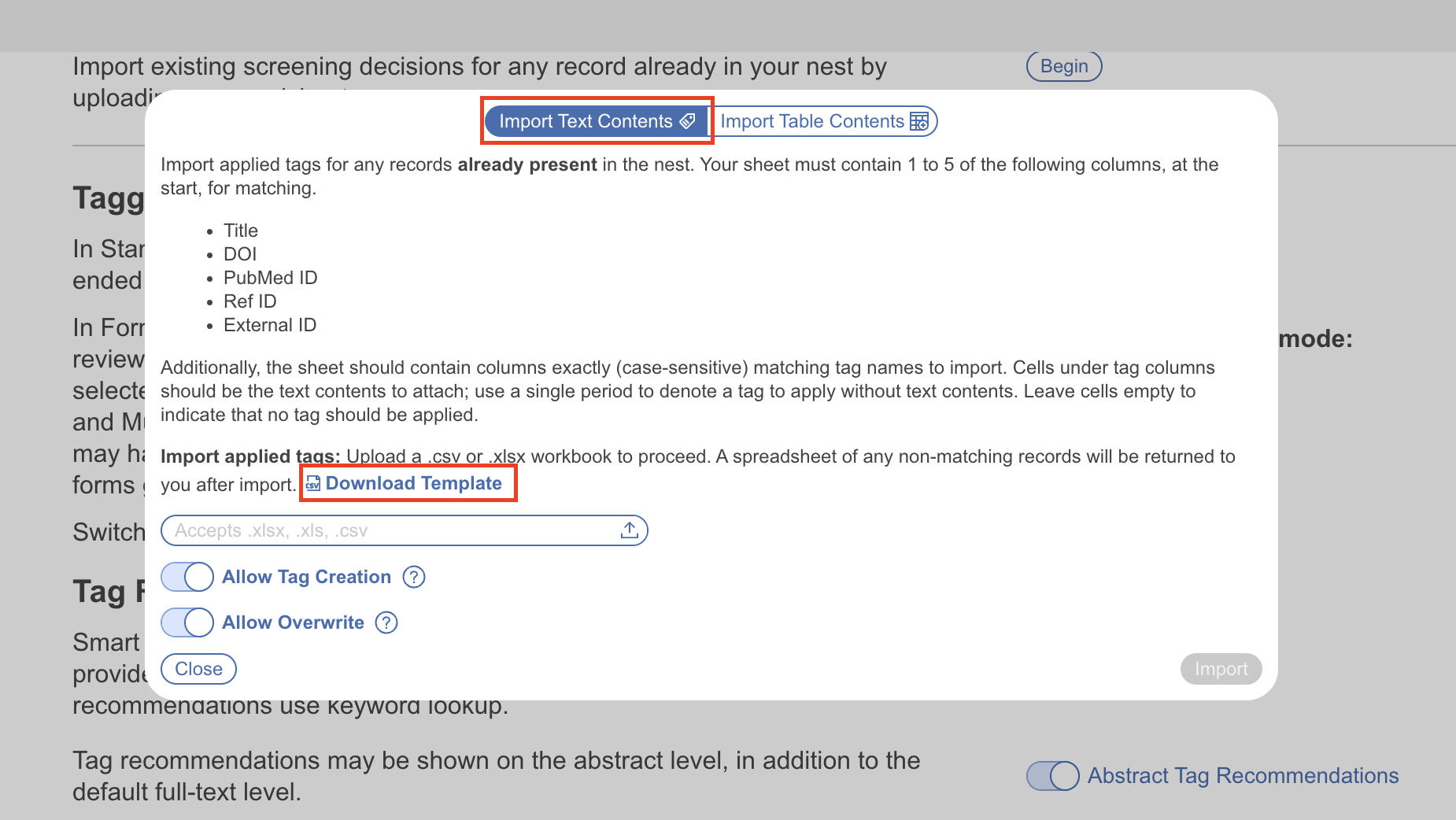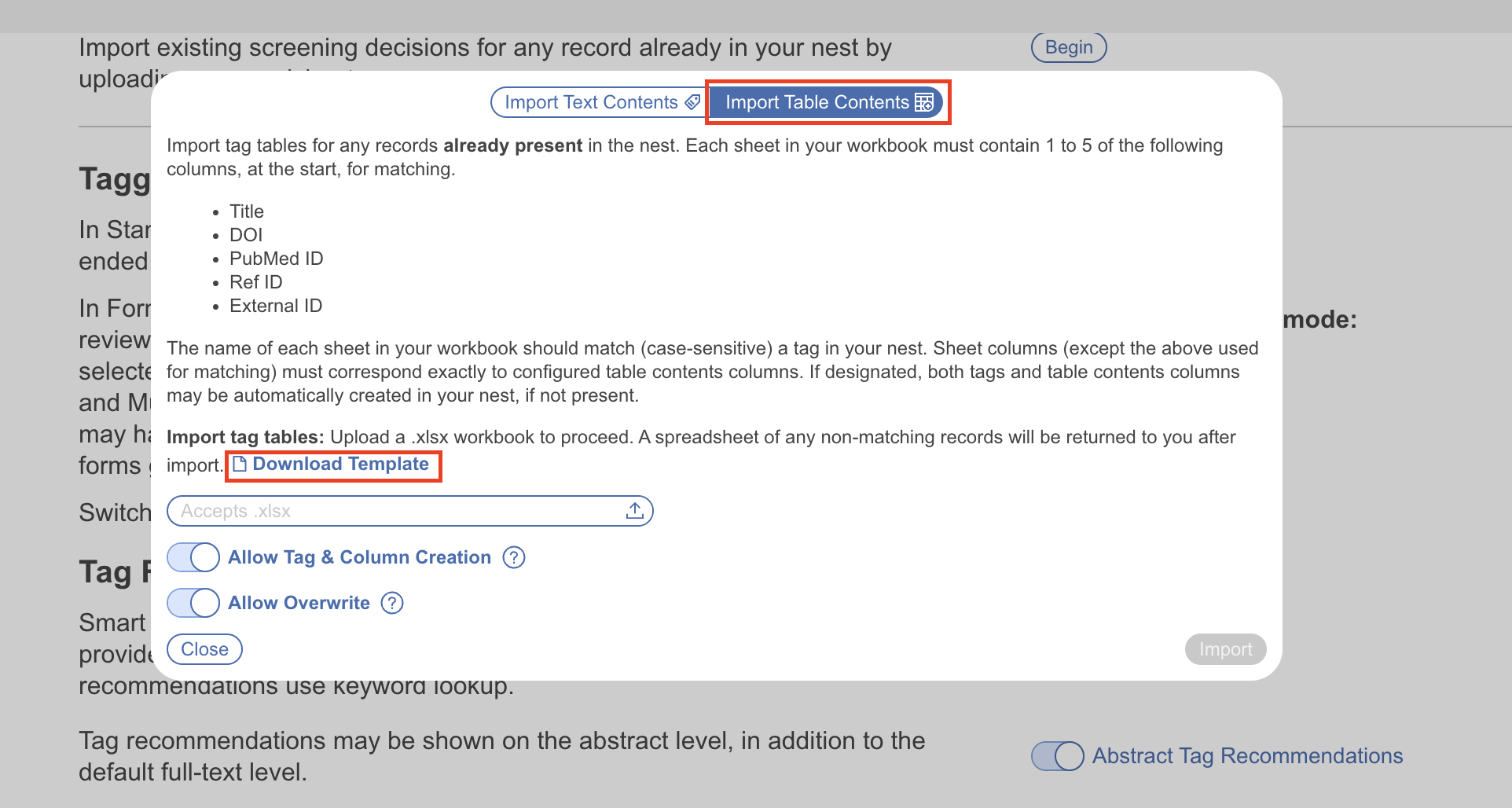Table of Contents
Import Existing Screening Decisions or Tags
This page addresses how to move existing review data, specifically screening & tagging, from spreadsheets into your nest. For video instructions, see T=2:37 in this video:
Where to Import
Import can be found under Settings.

- For Screening, see the “Import” section under Screening - select “Begin” under “Upload Data”
- For Tagging, see the “Import” section under Tagging - select “Begin” under “Upload Data”
You cannot import Screening and Tagging in a single sheet; all Import must be completed with only one module (Screening or Tagging) at a time.
Warning: New records CANNOT be added to the nest via Import; you can only adjust the Screening and Tagging of existing records in the nest. To import new records to the nest, see Import Records.
Import Screening Decisions
To import Screening Decisions, you will need to bring an Excel sheet or CSV formatted exactly as outlined below; you can use our template to ensure the formatting is correct.
Once you have selected “Begin,” a modal will open showing the ability to download the template, upload an Excel or CSV, and adjust settings:
Format and Template
You can download the template from the Import Modal:

The titles of your sheet must have the following exact column names:
- DOI
- Title
- PubMed Id
- Ref Id (if applicable)
- External Id
- Exclusion Reason
- [Optional] Full Text Review
You must provide, in those columns:
- At least one bibliographic item (DOI, Title, or PubMed Id)
- For all Included records, a blank cell in the Exclusion Reason column
- For all Excluded records, the exact Exclusion Reason
- For all records that underwent Full Text Review, the text “TRUE” in the Full Text Review cell.
See below for a correctly-filled-out example sheet (if using Ref ID, this would be an additional column):

In this sheet, the third record would be Included (with full text review) while the other three would have Exclusion Reasons added matching the text in that column.
Importing Abstract vs Full Text Screening Decisions
Using this method imports decisions as final screening decisions. However, if your nest is configured in a Two-Pass Screening mode (includes separate Abstract and Full Text Screening stages) you may wish to import decisions at the Final Abstract level or at the Final Full Text level. This can be done using the Full Text Review column:
- Final Abstract Screening Decisions: If you do not input a “Full Text Review” column, or if the column is included, but all corresponding cells are blank/have no value, decisions will be uploaded at the final abstract screening level
- Final Full Text Screening Decisions: If you input a column a “Full Text Review” column, and corresponding cells state “yes” or “true”, decisions will be uploaded at the final full text screening level
Note: it can be helpful to import screening decisions at the final abstract screening level to train Robot Screener in Dual Two Pass Screening!
Settings: Allow Exclusion Reason Creation
The first setting (first red arrow above) determines whether the nest should automatically create new Exclusion Reasons based on the imported sheet.
If there is an Exclusion Reason listed in the sheet that is not already configured in the nest, leaving this setting toggled “on” will automatically create any missing reasons.
If you would prefer that no new Exclusion Reasons be created in your nest, toggle this setting off.
If there are any Exclusion Reasons that do not exactly match Exclusion Reasons in the nest, the import of records with those non-matching Reasons will fail import and a list of records that failed Screening import will be displayed to you.
Settings: Allow overwrite
The second setting (second red arrow above) determines whether the decisions in your import should override decisions already present in the nest. That is, if you want any existing Exclusion Reason to be replaced by the imported decisions, leave this setting toggled “on.”
If you would prefer that existing decisions be left (and not overwritten), toggle this setting off. If toggled off, no overwriting will be completed over existing decisions.
Be careful about this action, because no report will be returned regarding overwriting of records!
Import Screening Decisions
Once you have ensured that your import sheet is the proper format, upload your sheet by drag-and-drop or by selecting the Upload button.
When complete, check your nest for the Screening Decisions you uploaded and to ensure that they were altered as you had planned.
Import Tags
To import Tags, you will need to bring an Excel sheet or CSV formatted exactly as outlined below; you can use our template to ensure the formatting is correct.
Once you have selected “Begin,” a modal will open showing the ability to download the template, upload an Excel or CSV, and adjust settings. In the modal, you have the ability to import tags with accompanying text contents and tags with table contents but note these imports are separate.
Tags with Text Contents
By default, importing tags with text contents is selected and tags with table contents can always be imported here or configured later on in your hierarchy. Imports must follow the correct format, you can download the template from the Import Modal:

The titles of your sheet must have 1-5 of the following exact column names:
- DOI
- Title
- PubMed Id
- Ref Id (if applicable)
- External Id
Then, every column to the right of these must be an exact Tag name; the cells under the Tag Name will indicate whether that Tag should be added to the record in question with the text in the cell as the Tag Excerpt.
You must provide, in those columns:
- At least one bibliographic item: DOI, Title, PubMed Id and, if applicable, Ref Id
- For all Tags to be applied to any record, the exact Tag name in the column header,
- For all records a Tag should be applied to, fill in your desired Text Content in the cell. If the cell is left blank, this indicates that the Tag in question should NOT be added to that record.
See below for a correctly-filled-out example sheet (if using Ref ID, this would be an additional column):

In this sheet, the first two records would have only one of the tags listed added to them; the last two records would have both tags added: “Study Type” and “Intervention.” The text added to each tag is found in the corresponding cell for each record.
Settings: Allow Tag Creation
The first setting determines whether the nest should automatically create new Tags based on the imported sheet.
If there is a Tag listed in the sheet that is not already configured in the nest, leaving this setting toggled “on” will automatically create any missing Tags.
These Tags will be added to your nest without Parent Tags, so make sure you check Configure Tagging and assign the appropriate Parent Tags after Import.
If you would prefer that no new Tags be created in your nest, toggle this setting off.
If there are any Tags that do not exactly match Tags in the nest, the import of records with those non-matching Tags will fail import and a list of records that failed Tag import will be displayed to you.
Settings: Allow overwrite
The second setting determines whether the tag excerpts in your import should override tag excerpts already present in the nest. That is, if you want any existing tag excerpts to be replaced by the imported excerpts, leave this setting toggled “on.”
If you would prefer that existing tags be left (and not overwritten), toggle this setting off. If toggled off, no overwriting will be completed over existing tags.
Be careful about this action, because no report will be returned regarding overwriting of records!
Import Tags with Text Contents
Once you have ensured that your import sheet is the proper format, upload your sheet by drag-and-drop or by selecting the Upload button.
When complete, check your nest for the new Tags you uploaded and to ensure that they were altered as you had planned.
Tags with Table Contents
For import of tags with accompanying tables, toggle “Import Table Contents.” This time, each sheet within your workbook should correspond (case-sensitive) to a tag in your nest you'd like to import a table for. Imports must follow the correct format, you can download the template from the Import Modal:

The titles of your sheet must have 1-5 of the following exact column names:
- DOI
- Title
- PubMed Id
- Ref Id (if applicable)
- External Id
Then, each remaining column must match exactly (case-sensitive) the columns configured in the pre-existing tag table. You can also have tags and columns created for your tag table by selecting “Allow Tag & Column Creation.”
Settings: Allow Tag Creation
The first setting determines whether the nest should automatically create new Tags based on the imported sheet.
When this is toggled on, new tags and corresponding tables will be created if they do not exist or they cannot be matched to existing tags in the nest.
These Tag tables will be added to your nest without Parent Tags, so make sure you check the Configure Tagging page and assign the appropriate Parent Tags after Import.
If you would prefer that no new Tag Tables be created in your nest, toggle this setting off.
If there are tag tables/sheets in your workbook that do not exactly match existing tags in the nest, the import of records with those non-matching Tags will fail import and a list of records that failed Tag import will be displayed to you.
Settings: Allow overwrite
The second setting determines whether the tag tables in your import should override tag tables already present in the nest. So if you want any existing tag tables to be replaced by the imported excerpts, leave this setting toggled “on.”
If you would prefer that existing tag tables be left (and not overwritten), toggle this setting off. If toggled off, no overwriting will be completed over existing tags.
Be careful about this action, because no report will be returned regarding overwriting of records!